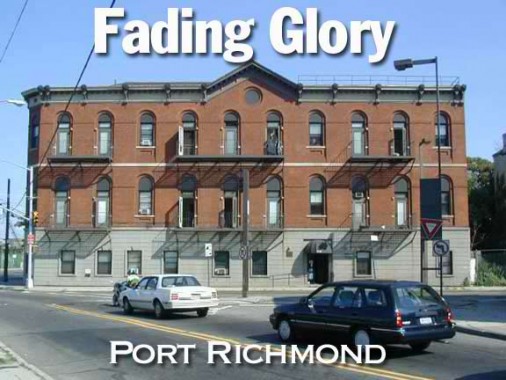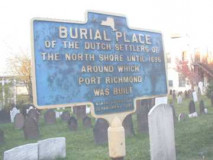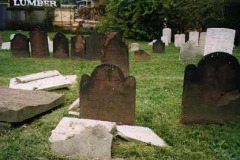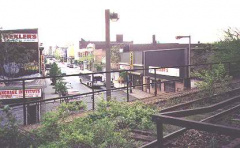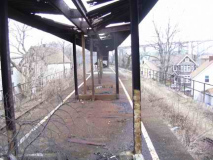The title is a little misleading; I’m here to praise Port Richmond, not to eulogize it. It’s just that rapid change seems to be coming to this former ferry and commuter town on Staten Island’s north shore and most of it isn’t good, if you like finely detailed, meticulously crafted architectural highlights.
I discovered Port Richmond…briefly…as early as the mid-1960s, when buses from Bay Ridge over the Verrazano Bridge extended their run from Clove Lakes Park to Richmond Terrace and Richmond Avenue. (Most of the major roads in Staten Island, Richmond County, are named Richmond.)
I seem to remember a bustling shopping district on Richmond Avenue and, unusually, a shopping stretch; in the 60s, it was one of Staten Island’s foremost.
Port Richmond has its beginnings in the 1690s and early 1700s when Dutch and French colonists settled here. After the landowning Haughwout family laid out the town’s tight street grid system in the 1830s the town became a commercial and industrial hub, and many of the buildings from Port Richmond’s “golden age” can still be found here. The Bayonne Bridge to New Jersey, the longest steel arch bridge in the world when it was completed, has provided a beautiful backdrop here since 1931.
Port Richmond has remained a commercial hub to the present, although the opening of the Staten Island Mall in the 1970s definitely put a dent in its fortunes. It remains the terminus of Staten Island’s main bus route from Bay Ridge, Brooklyn, the S53.
Port Richmond is an anachronism in more ways than one. It’s been passed by in the mall-ization of the island, as first Forest Avenue Shoppers Town, an early prototype mall, and then the mega-sized Staten Island Mall in New Springville siphoned away shoppers heretofore attracted to the main drag, Richmond Avenue. The island’s new building boom, located in Staten Island’s western and southern stretches, has also largely not included Port Richmond, so that its buildings are all fairly aged and in some cases rather forlorn-looking, though the de rigueur Fedders Specials are beginning to appear, as they are in most NYC neighborhoods.
One of the oldest structures in Port Richmond is the Reformed Church on Staten Island. The present church, which was built in 1844, is the third on the site. The first was built in 1715 and known as the Dutch Reformed Church; it was destroyed by fire during the Revolutionary War. The second was built in 1787. But the original church built in 1715 paled in age to the original “burying ground” it was constructed alongside, since the ancient cemetery dates to the late 1600s. The church and cemetery can be found at Port Richmond Avenue and Church Street. (The stretch of Richmond Avenue between Richmond Terrace and Forest Avenue was renamed Port Richmond Avenue in the late 1970s.)
Dead Railroad
ABOVE: Port Richmond Avenue from RR overpass; right: Tower Hill station at Sharpe Avenue. (May 2000 photos)
The north shore of Staten Island had passenger railroad service until 1953 when the Staten Island Rapid Transit‘s owner, the Baltimore and Ohio Railroad, closed it down for lack of patronage as the automobile continued to increase its dominance. Unusually, the old railroad infrastructure has been left in place in many spots, especially where it runs in an open cut or on a concrete elevated structure, and can be reactivated if it could be deemed feasible; while a return to passenger service is unfortunately unlikely, freight service to New Jersey may be in the cards as the Arthur Kill Bridge has recently undergone repairs and been reopened. The line, built in the 1880s, ran at grade until 1935 when it was raised above the street.
The lengthy brick building on the east side of Port Richmond Avenue between Richmond Terrace and Church Street was built in 1874 for Charles Griffith, a boot and shoe dealer, and is known as the Griffith Block. Directly abutting it on Richmond Terrace until 1945 was the St. James Hotel, known to be the last home of Aaron Burr, the third Vice President.
The Ritz Theatre, Port Richmond Avenue and Anderson Street, was built in 1924 with more than 2100 seats. Believe it or not, it was a prime rock venue in the 60s and 70s; the Kinks and Jethro Tull have played here. Since 1985 it has been the showroom for a tile company.
This massive building at Anderson Street and Park Avenue with six Ionic columns was once a Masonic temple, but it serves now as a community center and HQ for the local Catholic Youth Organization, ironic since the Masons and the Catholic Church have been traditional opponents.
A pair of sign designs from what appear to be the 1940s and 1970s on Port Richmond Avenue (photographed in 2005)
The Staten Island Advance spoke to the owners of the New Dinette in early 2006 about Port Richmond’s nascent revival:
If you ask Pete and Dora Skokos about Port Richmond Avenue, they’ll tell you it’s never been better. That’s their view from behind the counter of the New Dinette Restaurant at 187 Richmond Ave.
Don’t let the name fool you — there’s nothing “new” about this eatery. It still has the long diner-type counter with 10 stools and eight booths. It’s been in existence for decades, but under the operation of the Skokoses for the past 25 years.
“We’ve gone through several periods of changes in this community and, frankly, I think it’s improving,” explained Pete, who jokes he works “eight days a week.”
The New Dinette sits just opposite Harrison Avenue and smack in the middle of the once-famous Richmond Avenue shopping strip that extends from Beekman Street to Richmond Terrace. It featured businesses of all kinds from Loft’s where you could buy a box of candy for your sweetie or, if you were really crazy for her, a Cadillac at Crest Cadillac without ever leaving the “avenue.”
Sure, a lot of the changes resulted in the vanishing of once-popular stores like Lobels, Paul’s Men’s Shop, Garber Brothers, Archie Jacobson, jewelry stores like Reed’s and Goldwyn, bakeries, dress shops, record shops and meeting places like Stechman’s, the Ritz Tavern and theaters like the Palace, the Ritz and even the Empire down on the Terrace. The 5- and 10-cent stores included Fischer Beer, Woolworth and Kresge’s, Richmond Dry Goods, and so much more.” read the whole thing
Architecture buffs, help me out here. What are these items called? Port Richmond Avenue first, and then Richmond Terrace.
I can’t say for sure but this Port Richmond Ave. baker might be a Star Trek: Voyager fan, since the artwork bears some resemblance to Mr. Neelix, or maybe I’m being overimaginative.
Two generations of bank construction on Port Richmond Avenue.
The Leo Building, and one of the aforementioned former Port Richmond Avenue businesses, Lobels.
Richmond Terrace south of Port Richmond Avenue: Now the headquarters of Farrell Lumber, Port Richmond’s Empire Theater, with its two castle spires, was built in 1916 and closed for good, following a run as a porno palace, in 1978. It was designed by Port Richmond resident James Whitford.
Revealed Toscana Food Market sign, Port Richmond Avenue.
Port Richmond’s crosswalks and lampposts were installed in 1983, the result of a $1.2 million commercial revitalization project paid for by Federal Community Development block grants and planned by the Northfield Community Local Development Corporation, a private, nonprofit organization.
By 2006 they look very much of their time, when minimalist street sign and lamppost designs were the rage.
Behind the crosswalk, at Port Richmond Avenue and Post Avenue, is an incredible wall mural marking the site of an old theatre. Strangely I did not snap it on the day in 2005 I was there (if any Forgotten Fans can help me out with this it’d be appreciated).
Two blocks east of Port Richmond Avenue, its namesake neighborhood’s main shopping street, you find Heberton Avenue, one of New York’s hidden gems of preserved late 19th century architecture. The gems here reflect Port Richmond’s former status of commercial pre-eminence. Veterans Park, a town green between Park and Heberton Avenues and Bennett Street, overlooks a Carnegie Library and an A-framed house best described as a fantasy. Intriguingly, until the mid-20th Century Heberton was Herberton, with an extra “r.”
Port Richmond was a transportation hub for decades; horsecar, trolley and bus lines fed traffic to Bergen’s Ferry Landing, where boats crossed the Kill Van Kull to Bayonne. Manufacturing centered along Richmond Terrace, then as now, an industrial strip.
LEFT: 121 Heberton Avenue: This residence, constructed by carpenter-builder James G. Burger around 1859-61, is a rare surviving example in New York City of a picturesque villa in Rustic style. Notable features include the handsome bracketed door and window surrounds and the cross-gabled roof with overhanging eaves enriched with unusual braces. soon after its completion, this house passed to Captain John J. Housman,a prosperous oysterman and noted abolitionist. The house was leased to tenants until 1892 when it was acquired by Robert Brown, the owner of a neighboring saloon who held a number of offices in the Port Richmond government. The house remained in the ownership of the Brown family until the 1940s. info: nyc.gov
RIGHT: cottage from the same era at Ann Street and Park Avenue.
Old Public School 20 at Heberton and New Street was built in 1891 with an addition in 1898. It is the last clock-towered school building in Staten Island and is now a senior center.
Port Richmond’s library, here in 1905 view just after it opened, is at Bennett and Heberton Avenues opposite Veterans Park. Funds from industrialist/philanthropist Andrew Carnegie were emloyed to fund it; Carrere and Hastings, builders of Staten Island’s Borough Hall, were the architects. Other Carnegie libraries can be found throughout the city.
The stretch of Heberton Avenue between Ann Street and Post Avenue rivals St. Mark’s Place in St. George, Wards Hill and St. Paul’s Avenue in Stapleton for the variety and beauty of the dwellings you will find there. Too often, though, I found “for sale” signs on the front lawn. How many of these buildings will survive? Can any of them last beyond our era of cheap, multi-family houses?
Grace Methodist Church (now Faith United) at Heberton and Castleton Avenues, built 1897.
Heberton east of Castleton. This house belonged to one of the Deckers, a prominent Staten Island family.
Attached brick houses, Heberton Avenue near Ann Street. Right: bluestone sidewalks and white picket fences. The streets of heaven are lined with them.
St. John’s Evangelical Lutheran Church stands at a bend in Jewett Avenue north of Post. The church was established in 1852 with the present building erected in 1901; note the accompanying churchyard. Jewett Avenue is named for early 19th Century whaler John Jewett, who became a wealthy linseed oil manufacturer.
Future Star Studios, Post Avenue near Jewett, and (left) unusual pizzeria sign.
A newish Heberton Avenue building has a plaque recognizing the founder of the resident treatment facility.
Photographed in 2000, 2003 and 2005
erpietri@earthlink.net
©2006 Midnight Fish
